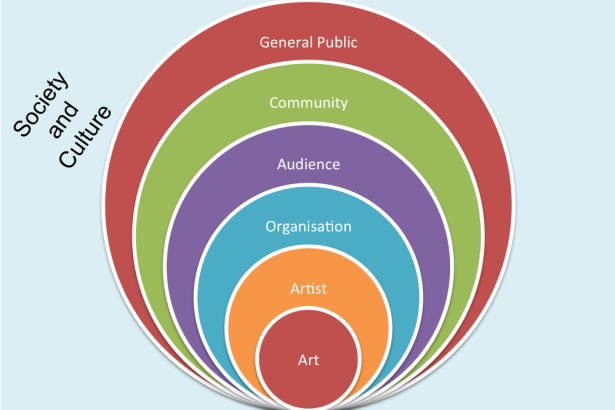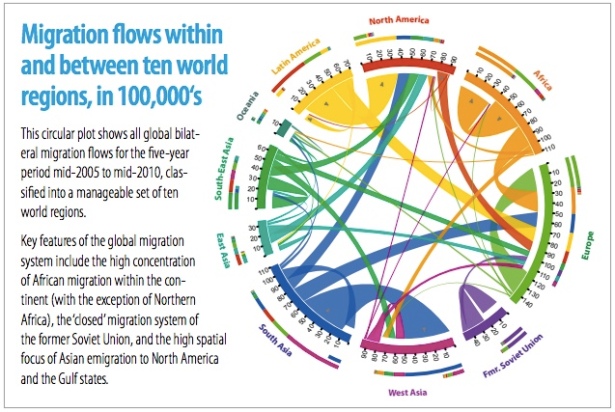This post comes from the Artists and Climate Change Blog
The question of impact in the arts is a vexing one. Not only is impact difficult to define, it is almost impossible to quantify. Talking about impact can create the expectation that the transaction between art and audience is predictable and replicable. But it is not. Good art is unpredictable and unique, and its impact doesn’t translate neatly into a spreadsheet. As a young playwright, I used to think that impact was measured by the size of the audience: How many people bought tickets? Eventually, I came to realize that this view was reductive. By focusing on numbers alone, I was overlooking smaller, subtler clues that revealed a much more profound and, I suspect, lasting impact.
Four groups, organized in concentric circles from smallest to biggest, are invited to experience the impacts of a work of art: the artist(s), the audience, the field, and the larger community. In the theatre, many artists – actors, directors, dramaturgs and designers, to name a few – are involved in the production of a play. Therefore, before the work is shared with an audience, it has the potential to affect many people. This became apparent to me when I was working on productions on my play Sila in 2014 and 2015. Set in the territory of Nunavut, Sila examines the impact of climate change on the Canadian Arctic and local Inuit population. As the themes from the play emerged through the rehearsal process, actors and directors became more attuned to the reality of climate change, dramaturgs formulated new research topics, and designers developed an interest in sustainability. That is impact.
After the artists, the next group to experience a work of art is the audience. In this case, numbers do tell a story. But by themselves, they don’t tell the whole story. Numbers are a refection of interest, not impact. Impact happens later, in the privacy of one’s home. It happens a day, a week, or even a year after encountering the work. And it is subtle. A friend once explained to me that political campaigns divide voters into categories, building a pie chart that separates groups into their political inclinations. The categories go from far left to far right, with a number of variations in between. The goal of the campaign is not to convince voters on the right to vote for the left, or vice versa. The goal is to move voters to the adjacent category in the chart. To affect one small, incremental change.
My plays focus on climate change. It would be tempting to think that impact means turning non-believers into activists. Or believers into fanatics. But that is unrealistic. Art opens up a space for conversation; it doesn’t, or shouldn’t, relentlessly push an agenda. We have to meet people where they are, and allow them to take their own journey, at their own pace. At best, I hope I can encourage people to move one step: to the adjacent category in the pie chart. Perhaps someone who doesn’t believe in climate change will be open to hearing more about it. Or perhaps someone who already believes will be inspired to take a more active role. That is impact.
Beyond the immediate transaction between artist and audience, the third group that can potentially be impacted by a work of art is the field. Every play is part of an ongoing conversation with the entire theatre community. As such, every play has the power to influence the next play – to expand our ideas about process, form, aesthetics, and ideology, and to shine a light on a conversation that may be missing from the stage. In collaboration with some colleagues, I have been working on a project called Climate Change Theatre Action (CCTA) in support of the United Nations Conference of the Parties. CCTA is a series of worldwide readings and performances intended to bring awareness to, and foster discussion around, climate change. For our last iteration in 2017, 140 events were presented in more than 20 countries. Many of these events are intimate; they take place in classrooms or rehearsal studios, with only a handful of people in attendance. But the conversation within the theatre community is far-reaching. Already, the project has shown that it is possible to address climate change without sacrificing artistic integrity; that local action can translate into a global movement and that the theatre is a powerful tool for social change.
CCTA also creates community. Fifty playwrights wrote 50 shorts plays that were made available to collaborators worldwide. For each event, collaborators select the plays they want to present and send us the list. We publicize this information on social media and connect collaborators with playwrights, and other collaborators. In addition to the local conversation happening around each event, a greater conversation is taking place across time zones between artists who have never met. Plays adapted into short films in California are being screened in Germany and India. Playwrights in the US are reading their plays live on Skype for events in Australia. And so on. Some of these relationships may outlive the project and lead to more collaborations. Some of these events may inspire other organizations to do similar events. That is impact.
Finally, the biggest of the four concentric circles is the larger community. Typically, this is not a group we think about. I certainly didn’t until I started focusing on climate change. Yet to achieve maximum impact, conversations have to transcend the walls of the theatre. With my play Sila, and the other seven plays of The Arctic Cycle, I strive to bring together people who may not normally encounter each other. I hope to build bridges between disciplines – science, policy, technology, humanities, and the arts. This means presenting the play in non-traditional settings such as academic conferences, scientific institutions, or university classes. It also means collaborating with earth and social scientists early in the process, inviting community stakeholders to participate in talkbacks, and engaging local environmental organizations. In 2014, excerpts of Sila served as the keynote for the conference “Warming Arctic: Development, Stewardship, Science†at Tufts University. The play introduced the topics that were going to be discussed during the conference, but framed them within personal narratives. It set a different tone for the conference and challenged scientists and policymakers to think beyond numbers. It also created a dialogue between science, policy, and the arts.
The same is true for the CCTA project. For one of the events in New York City in 2015, we invited a NASA climate scientist to talk about COP21 and the role of narrative in effecting social change. A dance company in Brooklyn, New York, invited a representative from the local chapter of the international organization 350.org to talk about their current initiatives. And various universities are incorporating their CCTA event into a larger conference that includes earth and social science, or in one case, leaders from three different faiths. This kind of cross-pollination promotes a better understanding of how people from different disciplines are tackling climate change, and how we can best support global efforts. It also creates a model for the kind of cross-disciplinary, cross-cultural collaboration that is possible in dealing with this global issue. That is impact.
Increasing self-awareness and affecting social change on a global level won’t happen overnight. It is unlikely someone will walk out of a play, sell his or her car, and sign up to Greenpeace. We do ourselves a disservice when we look for immediate impacts based on metrics. From time immemorial, the role of the arts has been to create the narrative that holds culture together. Rewriting that narrative won’t be easy. It is without a doubt the biggest, most fundamental shift humankind has ever had to make. Our job then is to celebrate every small step along the way. Our job is to recognize that there is potential for impact in every idea, every interaction, every performance, no matter how modest. Spreadsheets may lure us into thinking we are doing important work. But the faster we learn to see where meaningful impact is, the better our chances of creating the sustainable culture we desperately need to ensure our survival.
An earlier version of this article appeared in Fresh Perspectives 4: Art for the Planet’s Sake, published by IETM International Network for Contemporary Performing Arts, in December 2015.
______________________________
Chantal Bilodeau is a playwright and translator whose work focuses on the intersection of science, policy, art, and climate change. She is the Artistic Director of The Arctic Cycle – an organization created to support the writing, development and production of eight plays that look at the social and environmental changes taking place in the eight countries of the Arctic – and the founder of the blog and international network Artists & Climate Change. She is a co-organizer of Climate Change Theatre Action, a worldwide series of readings and performances of short climate change plays presented in support of the United Nations COP meetings.
Artists and Climate Change is a blog that tracks artistic responses from all disciplines to the problem of climate change. It is both a study about what is being done, and a resource for anyone interested in the subject. Art has the power to reframe the conversation about our environmental crisis so it is inclusive, constructive, and conducive to action. Art can, and should, shape our values and behavior so we are better equipped to face the formidable challenge in front of us.
















